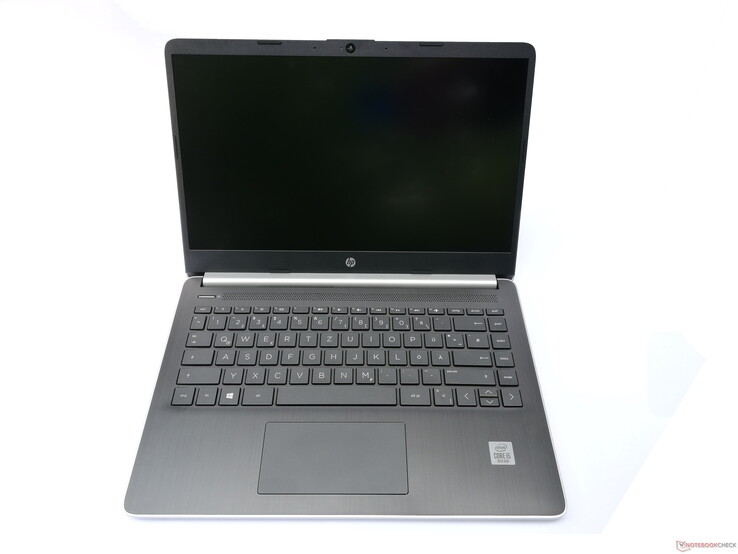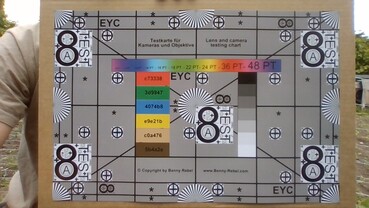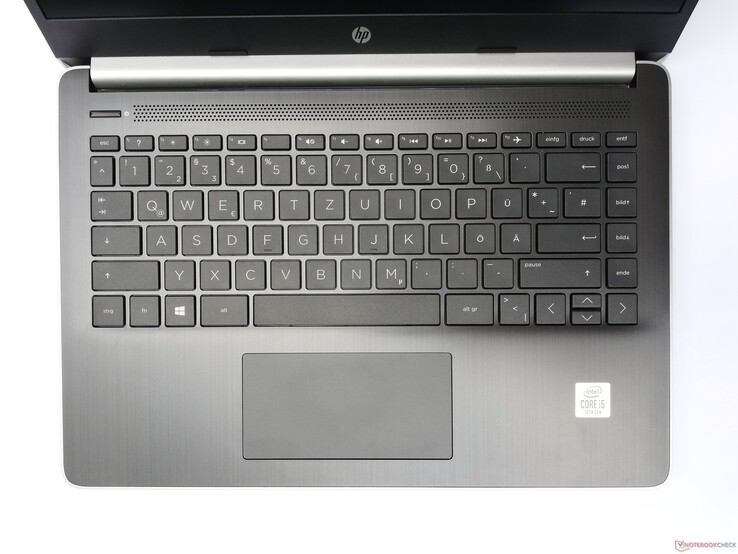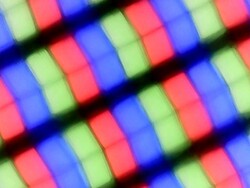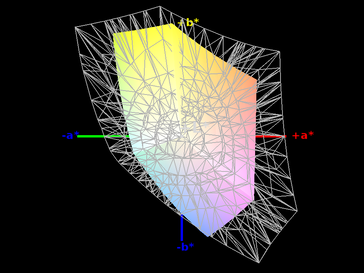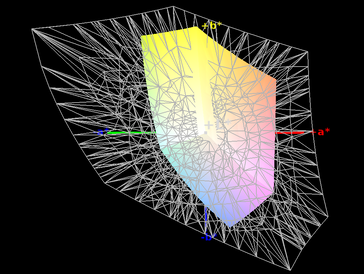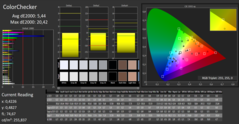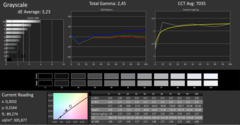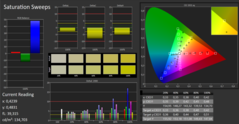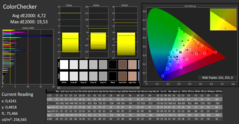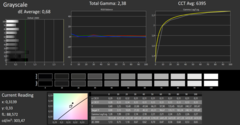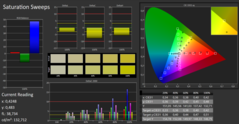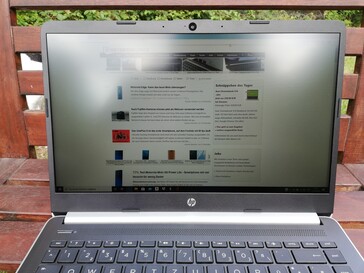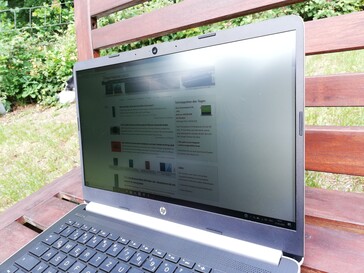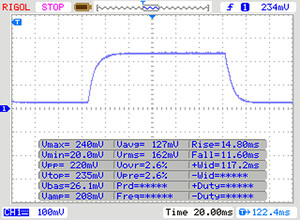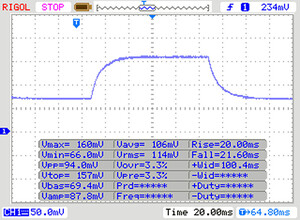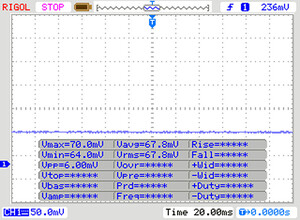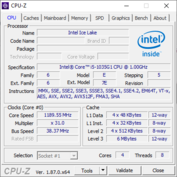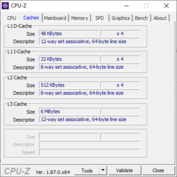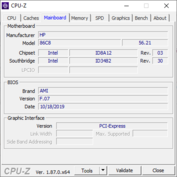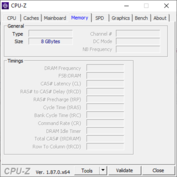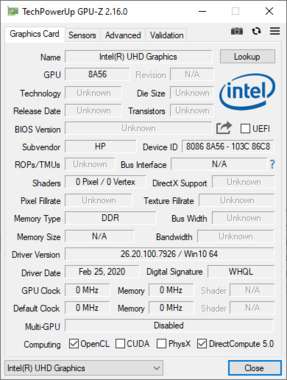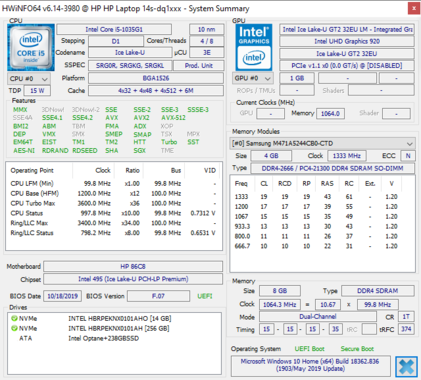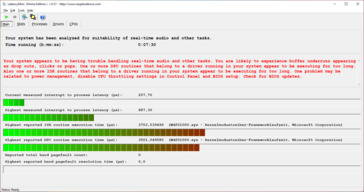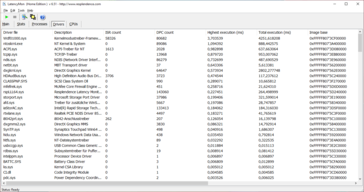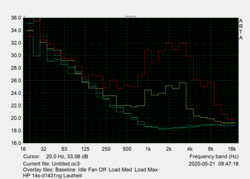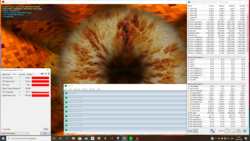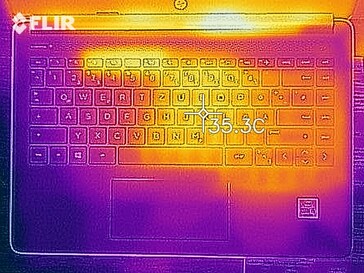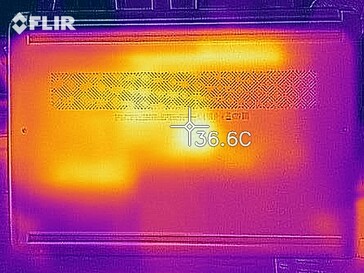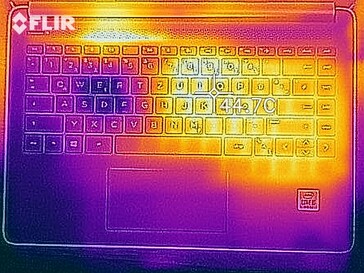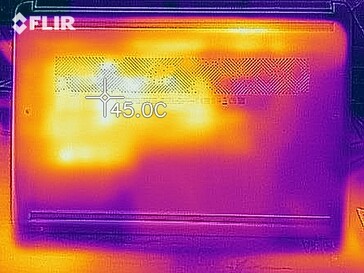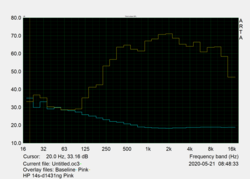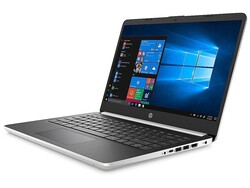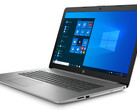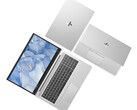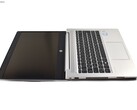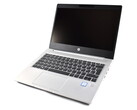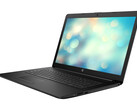HP 14s-dq1431ng Laptop in Review: Too noisy too often
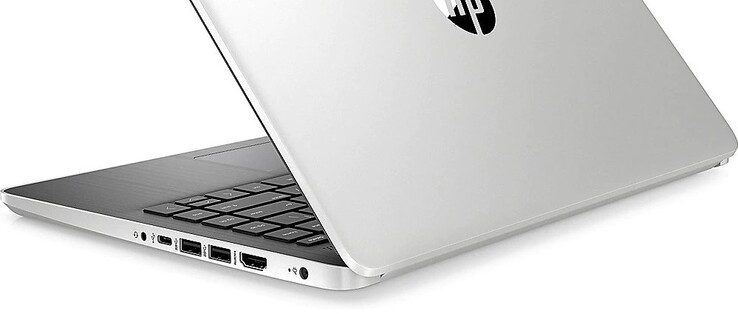
The HP 14s-dq1431ng is mostly a minor update that brings Ice Lake processors to the HP 14-based device. Other updates include connectivity and input devices. At prices of less than $600 the device is clearly targeting price-conscious customers.
The choice of affordable laptops is impressive, and we chose the competitors listed below to pit the HP 14s against. You can also add additional devices to compare the HP 14s to underneath each section.
Rating | Date | Model | Weight | Height | Size | Resolution | Price |
|---|---|---|---|---|---|---|---|
| 79.1 % v7 (old) | 06 / 2020 | HP 14s-dq1431ng i5-1035G1, UHD Graphics G1 (Ice Lake 32 EU) | 1.5 kg | 18 mm | 14.00" | 1920x1080 | |
| 79.2 % v7 (old) | 02 / 2020 | Acer Aspire 5 A514-52 i5-10210U, UHD Graphics 620 | 1.7 kg | 17.95 mm | 14.00" | 1920x1080 | |
| 74.5 % v7 (old) | 01 / 2020 | Dell Inspiron 14 3493-4KWCF i7-1065G7, GeForce MX230 | 1.8 kg | 21 mm | 14.00" | 1920x1080 | |
| 80.6 % v7 (old) | 10 / 2019 | Lenovo Ideapad C340-14API 81N6004UGE R5 3500U, Vega 8 | 1.7 kg | 17.9 mm | 14.00" | 1920x1080 | |
| 81.9 % v6 (old) | 06 / 2019 | HP 14-dk0008ng R7 3700U, Vega 10 | 1.5 kg | 20 mm | 14.00" | 1920x1080 |
Case – Robust HP Laptop with no Maintenance Options
While the bottom case is made of aluminum, the palm rests and display housing are made of plastic. The entire notebook looks and feels sturdy and well built. The display is held firmly in place by the single wide hinge, and it can be opened to a maximum angle of 140 degrees. There are several easily removable Philips screws at the bottom, but we were unable to remove the bottom case even after numerous extensive and time-consuming attempts.
At 1.5 kg the HP 14s is as lightweight as its HP 14 predecessor. It is not only the lightest notebook in our comparison group but also the one with the smallest footprint.
Connectivity – Affordable Laptop with USB-C
The 14s-dq1431ng no longer features a Gigabit Ethernet port but comes with a USB-C port instead. The remainder of the ports are limited to the bare necessities.
SD Card Reader
Inserted SD cards protrude from the 14s-dq1431ng’s SD card reader. When benchmarked with our 64 GB Toshiba Exceria Pro SDXC UHS-II reference card the device turned out to be fairly lethargic overall and scored last place in our comparison group.
| SD Card Reader | |
| average JPG Copy Test (av. of 3 runs) | |
| Lenovo Ideapad C340-14API 81N6004UGE (Toshiba Exceria Pro SDXC 64 GB UHS-II) | |
| Average of class Subnotebook (18.4 - 142, n=15, last 2 years) | |
| HP 14s-dq1431ng (Toshiba Exceria Pro SDXC 64 GB UHS-II) | |
| HP 14-dk0008ng (Toshiba Exceria Pro SDXC 64 GB UHS-II) | |
| maximum AS SSD Seq Read Test (1GB) | |
| Lenovo Ideapad C340-14API 81N6004UGE (Toshiba Exceria Pro SDXC 64 GB UHS-II) | |
| Average of class Subnotebook (22.5 - 207, n=15, last 2 years) | |
| HP 14s-dq1431ng (Toshiba Exceria Pro SDXC 64 GB UHS-II) | |
| HP 14-dk0008ng (Toshiba Exceria Pro SDXC 64 GB UHS-II) | |
Communication
Supported communication protocols include Wi-Fi 5 (802.11ac) and Bluetooth 5.0. When connected to our Netgear Nighthawk AX12 reference router the HP 14s managed very high average transfer rates of 632 Mb/s (RX) and 663 Mb/s (TX). The only devices even faster in its comparison group were the ones already equipped with Wi-Fi 6, such as the Acer Aspire 5 A514.
Webcam
The webcam captures video at a native resolution of 0.9 MP and was only capable of producing a crisp image under very good lighting conditions such as when we photographed our test chart outdoors. According to the ColorChecker Passport colors are significantly brighter than they should be.
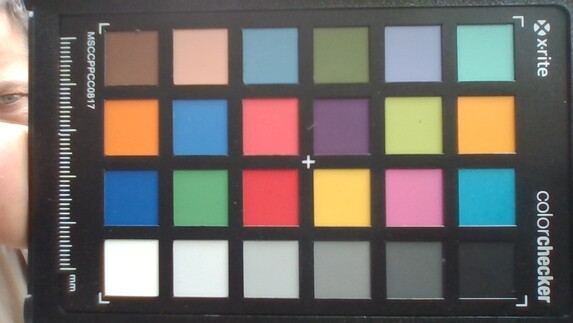
Accessories
Included in the box is the laptop itself and a charger. HP offers various accessories in its web shop, including some tailored specifically to the HP 14s, such as bags, peripherals, and more.
Maintenance
Even though we were able to easily remove all of the screws at the bottom of the HP 14s we failed to open the device. Users thus have to keep in mind that taking the notebook apart might cause irreversible damage and thus refrain from performing maintenance themselves.
Warranty
Default warranty is limited to 12 months and can be extended with optional warranty packages to up to three years. Prices and availability vary from one country and region to another. For example, HP’s Care Pack with pickup and return service for three years costs 72 Euros (~$80) in Germany.
Input Devices – Rattling Touchpad Steals all Thunder
Keyboard
The HP 14s features a keyboard that is, generally speaking, usable for avid typists. Key travel is fairly long but accentuation is a bit too spongy in return. Feedback is well defined, and the positioning of the cursor keys, Home, End, and Remove is okay. Our main gripes were the small cursor keys as well as the lack of a backlight.
Touchpad
Display – Bright and Flicker-Free
The 14-inch IPS panel runs at a native resolution of 1920x1080 and an acceptable average maximum brightness of 264 nits on both mains and battery. Unfortunately, at just 81% the brightness distribution was fairly low.
Given that HP does not use PWM for brightness regulation the display is flicker-free and well suited for users with sensitive eyes.
| |||||||||||||||||||||||||
Brightness Distribution: 81 %
Center on Battery: 260 cd/m²
Contrast: 1906:1 (Black: 0.16 cd/m²)
ΔE ColorChecker Calman: 5.44 | ∀{0.5-29.43 Ø4.79}
calibrated: 4.72
ΔE Greyscale Calman: 3.23 | ∀{0.09-98 Ø5}
58% sRGB (Argyll 1.6.3 3D)
37% AdobeRGB 1998 (Argyll 1.6.3 3D)
39.71% AdobeRGB 1998 (Argyll 3D)
57.7% sRGB (Argyll 3D)
38.42% Display P3 (Argyll 3D)
Gamma: 2.45
CCT: 7035 K
| HP 14s-dq1431ng AUO403D, IPS, 1920x1080, 14" | Acer Aspire 5 A514-52 Chi Mei N140HCA-EAC, IPS, 1920x1080, 14" | Dell Inspiron 14 3493-4KWCF Chi Mei 140HCA, IPS, 1920x1080, 14" | Lenovo Ideapad C340-14API 81N6004UGE BOE CQ NV140FHM-N48, IPS, 1920x1080, 14" | HP 14-dk0008ng AU Optronics AUO403D, IPS, 1920x1080, 14" | |
|---|---|---|---|---|---|
| Display | 8% | 9% | 3% | 3% | |
| Display P3 Coverage (%) | 38.42 | 41.39 8% | 41.84 9% | 39.63 3% | 39.53 3% |
| sRGB Coverage (%) | 57.7 | 62.2 8% | 62.3 8% | 58.6 2% | 59.1 2% |
| AdobeRGB 1998 Coverage (%) | 39.71 | 42.78 8% | 43.33 9% | 40.94 3% | 40.84 3% |
| Response Times | -23% | -12% | -17% | -1% | |
| Response Time Grey 50% / Grey 80% * (ms) | 41 ? | 55.6 ? -36% | 41 ? -0% | 43 ? -5% | 38 ? 7% |
| Response Time Black / White * (ms) | 25 ? | 27.6 ? -10% | 31 ? -24% | 32 ? -28% | 27 ? -8% |
| PWM Frequency (Hz) | 24510 ? | 2500 ? | 208 ? | ||
| Screen | -2% | -5% | -22% | 8% | |
| Brightness middle (cd/m²) | 305 | 237.8 -22% | 226 -26% | 285 -7% | 269 -12% |
| Brightness (cd/m²) | 264 | 231 -12% | 214 -19% | 273 3% | 257 -3% |
| Brightness Distribution (%) | 81 | 82 1% | 92 14% | 87 7% | 89 10% |
| Black Level * (cd/m²) | 0.16 | 0.32 -100% | 0.17 -6% | 0.4 -150% | 0.2 -25% |
| Contrast (:1) | 1906 | 743 -61% | 1329 -30% | 713 -63% | 1345 -29% |
| Colorchecker dE 2000 * | 5.44 | 3.41 37% | 5.21 4% | 5.62 -3% | 3.68 32% |
| Colorchecker dE 2000 max. * | 20.42 | 15.73 23% | 22.15 -8% | 17.22 16% | 7.36 64% |
| Colorchecker dE 2000 calibrated * | 4.72 | 3.12 34% | 4.43 6% | 4.8 -2% | |
| Greyscale dE 2000 * | 3.23 | 1.2 63% | 3.27 -1% | 3.97 -23% | 1.69 48% |
| Gamma | 2.45 90% | 2.05 107% | 2.36 93% | 2.28 96% | 2.49 88% |
| CCT | 7035 92% | 6395 102% | 6538 99% | 6848 95% | 6406 101% |
| Color Space (Percent of AdobeRGB 1998) (%) | 37 | 39.5 7% | 40 8% | 38 3% | 38 3% |
| Color Space (Percent of sRGB) (%) | 58 | 62.2 7% | 62 7% | 58 0% | 59 2% |
| Total Average (Program / Settings) | -6% /
-3% | -3% /
-3% | -12% /
-16% | 3% /
6% |
* ... smaller is better
According to our tests, the panel managed a very good contrast ratio of 1,906:1 and a very low black point of just 0.16 nits. Color-space coverage is average, which is not only expected of but also acceptable for a laptop at this price point.
CalMAN revealed that colors are a little bit on the blue side, which was easily addressed and remedied through calibration. The resulting ICC profile can be found for download in the box above.
Display Response Times
| ↔ Response Time Black to White | ||
|---|---|---|
| 25 ms ... rise ↗ and fall ↘ combined | ↗ 14 ms rise | |
| ↘ 11 ms fall | ||
| The screen shows relatively slow response rates in our tests and may be too slow for gamers. In comparison, all tested devices range from 0.1 (minimum) to 240 (maximum) ms. » 58 % of all devices are better. This means that the measured response time is worse than the average of all tested devices (20.3 ms). | ||
| ↔ Response Time 50% Grey to 80% Grey | ||
| 41 ms ... rise ↗ and fall ↘ combined | ↗ 20 ms rise | |
| ↘ 21 ms fall | ||
| The screen shows slow response rates in our tests and will be unsatisfactory for gamers. In comparison, all tested devices range from 0.165 (minimum) to 636 (maximum) ms. » 63 % of all devices are better. This means that the measured response time is worse than the average of all tested devices (31.7 ms). | ||
Screen Flickering / PWM (Pulse-Width Modulation)
| Screen flickering / PWM not detected | |||
In comparison: 53 % of all tested devices do not use PWM to dim the display. If PWM was detected, an average of 8167 (minimum: 5 - maximum: 343500) Hz was measured. | |||
Performance – Faster Load Times with Intel Optane
The HP 14s is aimed at home and office users looking for an affordable and portable laptop. The hardware is well-suited for nearly all office tasks, even for simple non-professional photo-editing. Demanding games are too much to ask for from the integrated GPU.
Processor
The HP 14s features an Intel Core i5-1035G1 Ice Lake processor running at between 1.0 and 3.6 GHz. It is supposed to be about as fast as the Intel Core i5-8365U thanks to its brand-new Sunnycove architecture. In our Cinebench R15 loop the HP notebook initially only scored half as high as we would have expected of a Core i5-1035G1. Performance increased to an acceptable and good level after a while but dropped again shortly thereafter. We suspect the strangely acting cooling system to be the main culprit for this odd behavior. The fans ramped up to full speed when launching an internet browser but remained silent for a very long time when running demanding applications and tasks.
Cinebench R15: CPU Single 64Bit | CPU Multi 64Bit
Blender: v2.79 BMW27 CPU
7-Zip 18.03: 7z b 4 -mmt1 | 7z b 4
Geekbench 5.5: Single-Core | Multi-Core
HWBOT x265 Benchmark v2.2: 4k Preset
LibreOffice : 20 Documents To PDF
R Benchmark 2.5: Overall mean
| Cinebench R20 / CPU (Single Core) | |
| Average of class Subnotebook (128 - 826, n=70, last 2 years) | |
| HP 14s-dq1431ng | |
| HP 14s-dq1431ng | |
| Average Intel Core i5-1035G1 (382 - 431, n=7) | |
| Acer Aspire 5 A514-52 | |
| Dell Inspiron 14 3493-4KWCF | |
| Lenovo Ideapad C340-14API 81N6004UGE | |
| HP 14-dk0008ng | |
| Cinebench R20 / CPU (Multi Core) | |
| Average of class Subnotebook (579 - 8541, n=70, last 2 years) | |
| Lenovo Ideapad C340-14API 81N6004UGE | |
| Dell Inspiron 14 3493-4KWCF | |
| Average Intel Core i5-1035G1 (1178 - 1873, n=7) | |
| HP 14s-dq1431ng | |
| HP 14s-dq1431ng | |
| Acer Aspire 5 A514-52 | |
| HP 14-dk0008ng | |
| Cinebench R15 / CPU Single 64Bit | |
| Average of class Subnotebook (72.4 - 322, n=71, last 2 years) | |
| Dell Inspiron 14 3493-4KWCF | |
| HP 14s-dq1431ng | |
| Acer Aspire 5 A514-52 | |
| Average Intel Core i5-1035G1 (144 - 171, n=8) | |
| Lenovo Ideapad C340-14API 81N6004UGE | |
| HP 14-dk0008ng | |
| Cinebench R15 / CPU Multi 64Bit | |
| Average of class Subnotebook (327 - 3345, n=73, last 2 years) | |
| Lenovo Ideapad C340-14API 81N6004UGE | |
| Dell Inspiron 14 3493-4KWCF | |
| Average Intel Core i5-1035G1 (518 - 803, n=11) | |
| HP 14s-dq1431ng | |
| HP 14-dk0008ng | |
| Acer Aspire 5 A514-52 | |
| Blender / v2.79 BMW27 CPU | |
| HP 14s-dq1431ng | |
| HP 14s-dq1431ng | |
| Average Intel Core i5-1035G1 (607 - 1002, n=9) | |
| Average of class Subnotebook (159 - 2271, n=73, last 2 years) | |
| 7-Zip 18.03 / 7z b 4 -mmt1 | |
| Average of class Subnotebook (2643 - 6442, n=72, last 2 years) | |
| HP 14s-dq1431ng | |
| HP 14s-dq1431ng | |
| Average Intel Core i5-1035G1 (3739 - 4318, n=8) | |
| HP 14-dk0008ng | |
| 7-Zip 18.03 / 7z b 4 | |
| Average of class Subnotebook (11668 - 77867, n=70, last 2 years) | |
| Average Intel Core i5-1035G1 (13236 - 20378, n=8) | |
| HP 14s-dq1431ng | |
| HP 14s-dq1431ng | |
| HP 14-dk0008ng | |
| Geekbench 5.5 / Single-Core | |
| Average of class Subnotebook (726 - 2350, n=66, last 2 years) | |
| HP 14s-dq1431ng | |
| HP 14s-dq1431ng | |
| Average Intel Core i5-1035G1 (1142 - 1240, n=7) | |
| Geekbench 5.5 / Multi-Core | |
| Average of class Subnotebook (2557 - 17218, n=66, last 2 years) | |
| Average Intel Core i5-1035G1 (3337 - 4372, n=7) | |
| HP 14s-dq1431ng | |
| HP 14s-dq1431ng | |
| HWBOT x265 Benchmark v2.2 / 4k Preset | |
| Average of class Subnotebook (0.97 - 25.1, n=70, last 2 years) | |
| Average Intel Core i5-1035G1 (3.32 - 6.44, n=8) | |
| HP 14s-dq1431ng | |
| HP 14s-dq1431ng | |
| HP 14-dk0008ng | |
| LibreOffice / 20 Documents To PDF | |
| HP 14s-dq1431ng | |
| HP 14s-dq1431ng | |
| Average Intel Core i5-1035G1 (55.3 - 70.9, n=6) | |
| Average of class Subnotebook (38.5 - 220, n=69, last 2 years) | |
| R Benchmark 2.5 / Overall mean | |
| Average Intel Core i5-1035G1 (0.705 - 0.769, n=7) | |
| HP 14s-dq1431ng | |
| HP 14s-dq1431ng | |
| Average of class Subnotebook (0.403 - 1.456, n=71, last 2 years) | |
* ... smaller is better
System Performance
Both PCMark 8 and 10 scores were pretty poor overall. Only in PCMark 8 Home did the HP 14s achieve a score that was not too far behind our expectations. Everyday usability was smooth and without lag. Applications launched quickly, and accessing files was performed without noticeable delays.
Additional results, including those of other laptops, can be found in our CPU benchmark list.
| PCMark 8 Home Score Accelerated v2 | 3545 points | |
| PCMark 8 Work Score Accelerated v2 | 2790 points | |
| PCMark 10 Score | 3676 points | |
Help | ||
DPC Latencies
| DPC Latencies / LatencyMon - interrupt to process latency (max), Web, Youtube, Prime95 | |
| HP 14s-dq1431ng | |
* ... smaller is better
Storage Devices
The HP 14s-dq1431ng was equipped with a 256 GB large SSD as well as 16 GB of Intel Optane memory. The latter is supposed to buffer frequently used data to lower access times thereto, thereby performing as fast as a high-end SSD.
However, this effect cannot be measured in our storage benchmarks since those only reflect the SSD’s performance. Accordingly, the results were just average at best. Our long-term sustained load test revealed that performance does not decrease over time.
See how well other storage devices performed on our HDD/SSD benchmark page.
| HP 14s-dq1431ng Intel Optane Memory H10 with Solid State Storage 16GB + 256GB HBRPEKNX0101AH | Acer Aspire 5 A514-52 WDC PC SN520 SDAPNUW-512G | Dell Inspiron 14 3493-4KWCF Toshiba KBG40ZNS512G NVMe | Lenovo Ideapad C340-14API 81N6004UGE Samsung SSD PM981 MZVLB256HAHQ | HP 14-dk0008ng Samsung PM871b MZNLN128HAHQ | Average Intel Optane Memory H10 with Solid State Storage 16GB + 256GB HBRPEKNX0101AH | |
|---|---|---|---|---|---|---|
| CrystalDiskMark 5.2 / 6 | 80% | 69% | 89% | -33% | 0% | |
| Write 4K (MB/s) | 142.8 | 166.6 17% | 159.6 12% | 132.9 -7% | 90.6 -37% | 142.8 ? 0% |
| Read 4K (MB/s) | 167.4 | 46.72 -72% | 53.5 -68% | 42.75 -74% | 33.17 -80% | 167.4 ? 0% |
| Write Seq (MB/s) | 232.1 | 1458 528% | 1174 406% | 1447 523% | 483 108% | 232 ? 0% |
| Read Seq (MB/s) | 1128 | 1387 23% | 1648 46% | 2134 89% | 511 -55% | 1128 ? 0% |
| Write 4K Q32T1 (MB/s) | 438 | 419.5 -4% | 420.8 -4% | 252 -42% | 170.7 -61% | 438 ? 0% |
| Read 4K Q32T1 (MB/s) | 491.2 | 487.8 -1% | 564 15% | 334.2 -32% | 235 -52% | 491 ? 0% |
| Write Seq Q32T1 (MB/s) | 622 | 1456 134% | 1231 98% | 1447 133% | 496.5 -20% | 622 ? 0% |
| Read Seq Q32T1 (MB/s) | 1566 | 1733 11% | 2274 45% | 3522 125% | 534 -66% | 1566 ? 0% |
| AS SSD | 116% | 94% | 156% | -16% | 0% | |
| Seq Read (MB/s) | 677 | 1244 84% | 2074 206% | 2547 276% | 491.6 -27% | 677 ? 0% |
| Seq Write (MB/s) | 194.7 | 1393 615% | 775 298% | 1365 601% | 473.9 143% | 194.7 ? 0% |
| 4K Read (MB/s) | 58.1 | 46.86 -19% | 37.81 -35% | 44.52 -23% | 26.82 -54% | 58.1 ? 0% |
| 4K Write (MB/s) | 124.1 | 135.1 9% | 101.3 -18% | 102.2 -18% | 57.8 -53% | 124.1 ? 0% |
| 4K-64 Read (MB/s) | 219.6 | 650 196% | 1265 476% | 826 276% | 244.3 11% | 220 ? 0% |
| 4K-64 Write (MB/s) | 638 | 789 24% | 383.5 -40% | 1162 82% | 154.9 -76% | 638 ? 0% |
| Access Time Read * (ms) | 0.109 | 0.045 59% | 0.081 26% | 0.063 42% | 0.119 -9% | 0.109 ? -0% |
| Access Time Write * (ms) | 0.065 | 0.027 58% | 0.263 -305% | 0.037 43% | 0.062 5% | 0.065 ? -0% |
| Score Read (Points) | 345 | 821 138% | 1510 338% | 1125 226% | 320 -7% | 345 ? 0% |
| Score Write (Points) | 782 | 1064 36% | 562 -28% | 1401 79% | 260 -67% | 782 ? 0% |
| Score Total (Points) | 1305 | 2326 78% | 2781 113% | 3052 134% | 753 -42% | 1305 ? 0% |
| Total Average (Program / Settings) | 98% /
101% | 82% /
83% | 123% /
128% | -25% /
-23% | 0% /
0% |
* ... smaller is better
Sustained read: DiskSpd Read Loop, Queue Depth 8
GPU Performance
All things graphics are handled by an integrated Intel UHD Graphics G1 GPU. It does not have exclusive access to its own memory but relies on a shared memory architecture instead and thus benefits immensely from a dual-channel RAM setup. Overall performance was fairly low and only fast enough for undemanding and modest applications.
While the HP 14s performed slightly above average in 3DMark 11, the UHD Graphics G1 scored slightly below average in Fire Strike and Cloud Gate. See how other GPUs performed on our GPU benchmark page.
| 3DMark 11 Performance | 2677 points | |
| 3DMark Cloud Gate Standard Score | 10185 points | |
| 3DMark Fire Strike Score | 1468 points | |
Help | ||
Gaming Performance
The HP 14s is only fast enough for modest or older games. Modern demanding titles only managed frame rates too low for a smooth gaming experience. In addition, we had to lower the display resolution to 1366x768 in the older Dota 2 Reborn in order to achieve frame rates of more than 30 FPS.
Take a look at our GPU game list in order to find out what games will run smoothly with an Intel UHD Graphics G1.
| Final Fantasy XV Benchmark - 1280x720 Lite Quality | |
| Average of class Subnotebook (21.4 - 111.6, n=72, last 2 years) | |
| Average Intel UHD Graphics G1 (Ice Lake 32 EU) (13 - 16.8, n=8) | |
| HP 14s-dq1431ng | |
| X-Plane 11.11 | |
| 1280x720 low (fps_test=1) | |
| Average of class Subnotebook (29.9 - 144.7, n=73, last 2 years) | |
| HP 14s-dq1431ng | |
| Average Intel UHD Graphics G1 (Ice Lake 32 EU) (17.3 - 32.9, n=10) | |
| 1920x1080 med (fps_test=2) | |
| Average of class Subnotebook (25.1 - 116.2, n=64, last 2 years) | |
| HP 14s-dq1431ng | |
| Average Intel UHD Graphics G1 (Ice Lake 32 EU) (10.4 - 15.3, n=10) | |
| 1920x1080 high (fps_test=3) | |
| Average of class Subnotebook (20.7 - 97.1, n=64, last 2 years) | |
| HP 14s-dq1431ng | |
| Average Intel UHD Graphics G1 (Ice Lake 32 EU) (10.7 - 14.4, n=10) | |
| low | med. | high | ultra | |
|---|---|---|---|---|
| Dota 2 Reborn (2015) | 65.6 | 38.7 | 22.7 | 20.7 |
| Final Fantasy XV Benchmark (2018) | 13.2 | |||
| X-Plane 11.11 (2018) | 28.8 | 13.9 | 13.2 |
Emissions – Loud Fans and Tinny Speakers
System Noise
Noise level
| Idle |
| 31.2 / 31.2 / 31.2 dB(A) |
| Load |
| 35.2 / 41.2 dB(A) |
 | ||
30 dB silent 40 dB(A) audible 50 dB(A) loud |
||
min: | ||
Temperature
Core temperatures climbed to 86 °C during our one-hour long stress test. Frequencies dropped to just 1.2 GHz, which is still above the CPU’s base clock speed of 1 GHz. At the very end of our stress test the device was very lethargic and slow overall but sped up to previous levels of performance immediately after we quit all load-inducing applications.
(+) The maximum temperature on the upper side is 38 °C / 100 F, compared to the average of 35.9 °C / 97 F, ranging from 21.4 to 59 °C for the class Subnotebook.
(+) The bottom heats up to a maximum of 37.8 °C / 100 F, compared to the average of 39.3 °C / 103 F
(+) In idle usage, the average temperature for the upper side is 25.9 °C / 79 F, compared to the device average of 30.8 °C / 87 F.
(+) The palmrests and touchpad are cooler than skin temperature with a maximum of 26.4 °C / 79.5 F and are therefore cool to the touch.
(±) The average temperature of the palmrest area of similar devices was 28.2 °C / 82.8 F (+1.8 °C / 3.3 F).
Speakers
The speakers were relatively quiet overall but offered a wide soundscape with slightly overpronounced high mids. However, they are not suitable for media consumption due to the fact that even Windows sound effects already produced a clearly audible rattle. Users will thus have to use external speakers or headphones instead.
HP 14s-dq1431ng audio analysis
(-) | not very loud speakers (71 dB)
Bass 100 - 315 Hz
(-) | nearly no bass - on average 20.5% lower than median
(±) | linearity of bass is average (10.5% delta to prev. frequency)
Mids 400 - 2000 Hz
(+) | balanced mids - only 3.4% away from median
(+) | mids are linear (5.9% delta to prev. frequency)
Highs 2 - 16 kHz
(+) | balanced highs - only 1.9% away from median
(+) | highs are linear (5.7% delta to prev. frequency)
Overall 100 - 16.000 Hz
(±) | linearity of overall sound is average (19.8% difference to median)
Compared to same class
» 62% of all tested devices in this class were better, 7% similar, 32% worse
» The best had a delta of 5%, average was 18%, worst was 53%
Compared to all devices tested
» 49% of all tested devices were better, 7% similar, 44% worse
» The best had a delta of 4%, average was 24%, worst was 134%
Apple MacBook 12 (Early 2016) 1.1 GHz audio analysis
(+) | speakers can play relatively loud (83.6 dB)
Bass 100 - 315 Hz
(±) | reduced bass - on average 11.3% lower than median
(±) | linearity of bass is average (14.2% delta to prev. frequency)
Mids 400 - 2000 Hz
(+) | balanced mids - only 2.4% away from median
(+) | mids are linear (5.5% delta to prev. frequency)
Highs 2 - 16 kHz
(+) | balanced highs - only 2% away from median
(+) | highs are linear (4.5% delta to prev. frequency)
Overall 100 - 16.000 Hz
(+) | overall sound is linear (10.2% difference to median)
Compared to same class
» 7% of all tested devices in this class were better, 2% similar, 91% worse
» The best had a delta of 5%, average was 18%, worst was 53%
Compared to all devices tested
» 4% of all tested devices were better, 1% similar, 94% worse
» The best had a delta of 4%, average was 24%, worst was 134%
Power Consumption – HP 14s runs less than 6 hours in our Wi-Fi test
Power Consumption
With a power consumption of at least 4.5 W and a maximum of 46 W under load the HP 14s-dq1431ng landed somewhere in the middle of our comparison group. Its power consumption was average overall, and the included 45 W power supply was more than sufficiently dimensioned.
| Off / Standby | |
| Idle | |
| Load |
|
Key:
min: | |
| HP 14s-dq1431ng i5-1035G1, UHD Graphics G1 (Ice Lake 32 EU), Intel Optane Memory H10 with Solid State Storage 16GB + 256GB HBRPEKNX0101AH, IPS, 1920x1080, 14" | Acer Aspire 5 A514-52 i5-10210U, UHD Graphics 620, WDC PC SN520 SDAPNUW-512G, IPS, 1920x1080, 14" | Dell Inspiron 14 3493-4KWCF i7-1065G7, GeForce MX230, Toshiba KBG40ZNS512G NVMe, IPS, 1920x1080, 14" | Lenovo Ideapad C340-14API 81N6004UGE R5 3500U, Vega 8, Samsung SSD PM981 MZVLB256HAHQ, IPS, 1920x1080, 14" | HP 14-dk0008ng R7 3700U, Vega 10, Samsung PM871b MZNLN128HAHQ, IPS, 1920x1080, 14" | Average Intel UHD Graphics G1 (Ice Lake 32 EU) | Average of class Subnotebook | |
|---|---|---|---|---|---|---|---|
| Power Consumption | 28% | -19% | -15% | -1% | 2% | -19% | |
| Idle Minimum * (Watt) | 4.5 | 2.7 40% | 4.7 -4% | 5.1 -13% | 4.8 -7% | 4.13 ? 8% | 4.12 ? 8% |
| Idle Average * (Watt) | 7.7 | 3 61% | 6.6 14% | 7.2 6% | 7.1 8% | 7.07 ? 8% | 7.01 ? 9% |
| Idle Maximum * (Watt) | 8.7 | 4.6 47% | 5.9 32% | 9.7 -11% | 7.3 16% | 8.36 ? 4% | 8.63 ? 1% |
| Load Average * (Watt) | 27 | 29.3 -9% | 56 -107% | 40 -48% | 34 -26% | 30.6 ? -13% | 44.7 ? -66% |
| Load Maximum * (Watt) | 46 | 45.4 1% | 60.2 -31% | 49 -7% | 45 2% | 45.6 ? 1% | 68.6 ? -49% |
* ... smaller is better
Battery Life
When subjected to our real-life Wi-Fi battery test the HP 14s-dq1431ng managed a battery life of just 5:34 hours. This may not be bad per se, however the HP 14-dk0008ng managed to squeeze out a significantly longer battery life out of the exact same 41 Wh battery. Charging the HP 14s with the included power supply from near empty to full takes around two hours.
| HP 14s-dq1431ng i5-1035G1, UHD Graphics G1 (Ice Lake 32 EU), 41 Wh | Acer Aspire 5 A514-52 i5-10210U, UHD Graphics 620, 51 Wh | Dell Inspiron 14 3493-4KWCF i7-1065G7, GeForce MX230, 42 Wh | Lenovo Ideapad C340-14API 81N6004UGE R5 3500U, Vega 8, 45 Wh | HP 14-dk0008ng R7 3700U, Vega 10, 41.04 Wh | Average of class Subnotebook | |
|---|---|---|---|---|---|---|
| Battery runtime | 54% | 5% | 34% | -10% | 103% | |
| Reader / Idle (h) | 12.1 | 22.7 88% | 13.8 14% | 11.8 -2% | 32.9 ? 172% | |
| WiFi v1.3 (h) | 5.6 | 9.4 68% | 6.5 16% | 7.5 34% | 7.2 29% | 13.2 ? 136% |
| Load (h) | 1.9 | 2 5% | 1.6 -16% | 0.8 -58% | 1.924 ? 1% |
Pros
Cons
Verdict – More Fine-Tuning Would Have Been Nice
HP’s 14s-dq1431ng has a lot of pros, but the list of shortcomings is just as long, ultimately resulting in a significantly lower score than it could have achieved because they are majorly disruptive in everyday use. For example, do the fans really have to ramp up every single time when launching a simple web browser? Does the trackpad really have to imitate an agitated rattle snake at every touch of the finger? Why can't users open the device in order to perform maintenance? This is a limitation that is completely unnecessary in our opinion.
If HP had paid more attention to quality then the HP 14s-dq1431ng could have been a good notebook.
Users that do not mind these drawbacks get a usable laptop in return. It offers more than enough performance for various office tasks, a good Wi-Fi performance, and a keyboard well usable for typing. Its short battery life is acceptable considering the laptop’s low price. However, we can only recommend the device if after taking everything into consideration and looking at all possible alternatives you still continue to not mind the device's cons.
HP 14s-dq1431ng
- 06/03/2020 v7 (old)
Mike Wobker




